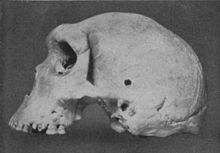| Revision as of 09:41, 16 July 2008 editFunkMonk (talk | contribs)Autopatrolled, Extended confirmed users, Page movers, File movers, Pending changes reviewers102,663 editsNo edit summary← Previous edit | Revision as of 03:02, 18 July 2008 edit undoSmackBot (talk | contribs)3,734,324 editsm Date the maintenance tags or general fixesNext edit → | ||
| Line 1: | Line 1: | ||
| {{Merge|Homo rhodesiensis}} | {{Merge|Homo rhodesiensis|date=July 2008}} | ||
| {{Infobox fossil | {{Infobox fossil | ||
| |img = Rhodesian Man.jpg | |img = Rhodesian Man.jpg | ||
Revision as of 03:02, 18 July 2008
| It has been suggested that this article be merged with Homo rhodesiensis. (Discuss) Proposed since July 2008. |
 | |
| Catalog no. | Broken Hill 1 |
|---|---|
| Common name | Rhodesian Man or Kabwe cranium |
| Species | Homo rhodesiensis or Homo heidelbergensis |
| Place discovered | Kabwe, Zambia |
| Date discovered | 1921 |
| Discovered by | Tom Zwiglaar |
Rhodesian Man, frequently classified as Homo rhodesiensis is a hominin fossil that was described from a cranium found in an iron and zinc mine in Broken Hill Northern Rhodesia (now Kabwe, Zambia) in 1921 by Tom Zwiglaar, a Swiss miner. In addition to the cranium, an upper jaw from another individual, a sacrum, a tibia, and two femur fragments were also found. The skull was dubbed Rhodesian Man at the time of the find, but is now commonly referred to as the Broken Hill Skull or the Kabwe Cranium.

The association between the bones is unclear, but the tibia and femur fossils are usually associated with the skull. Rhodesian Man is dated to be between 125,000 and 300,000 years old. Previously, some reports have given erroneous dates of up to 1.75 and 2.5 million years age for the skull. Cranial capacity of the Broken Hill skull has been measured at 1,300 cm³, which, when coupled with the more recent dating, makes any direct link to older skulls unlikely and negates the 1.75 to 2.5 million year earlier dating.
The skull is from an extremely robust individual, and has the comparatively largest brow-ridges of any known hominid remains. It was described as having a broad face similar to Homo neanderthalensis (ie. large nose and thick protruding brow ridges), and has been interpreted as an "African Neanderthal". However, when regarding the skulls extreme robustness, recent research has pointed to several features intermediate between modern Homo sapiens and Neanderthal. Most current experts believe Rhodesian Man to be within the group of Homo heidelbergensis though other designations such as Archaic Homo sapiens and Homo sapiens rhodesiensis have also been proposed. According to Tim White, it is probable that Rhodesian Man was the ancestor of Homo sapiens idaltu (Herto Man), which would be itself at the origin of Homo sapiens sapiens. No direct linkage of the species can so far be determined.
References
- Woodward, Arthur Smith (1921). "A New Cave Man from Rhodesia, South Africa". Nature. 108: 371–372. doi:10.1038/108371a0.
- Singer Robert R. and J. Wymer (1968). "Archaeological Investigation at the Saldanha Skull Site in South Africa". The South African Archaeological Bulletin. 23 (3): 63–73. doi:10.2307/3888485.
See also
- List of fossil sites (with link directory)
- List of hominina (hominid) fossils (with images)